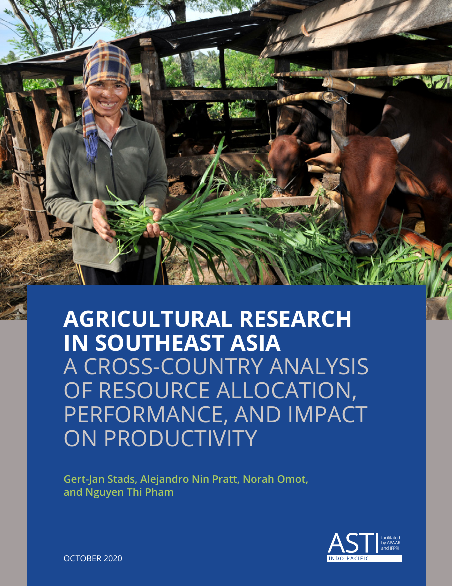Authors:
Gert-Jan Stads, Alejandro Nin Pratt, Norah Omot, and Nguyen Thi Pham
Year:
2020
Publisher
International Food Policy Research Institute, Asia Pacific Association of Agricultural Research Institutions
Back to:
Southeast Asia made considerable progress in building and strengthening its agricultural R&D capacity during 2000–2017. All of the region’s countries reported higher numbers of agricultural researchers, improvements in their average qualification levels, and higher shares of women participating in agricultural R&D. In contrast, regional agricultural research spending remained stagnant, despite considerable growth in agricultural output over time. As a result, Southeast Asia’s agricultural research intensity—that is, agricultural research spending as a share of agricultural GDP—steadily declined from 0.50 percent in 2000 to just 0.33 percent in 2017. Although the extent of underinvestment in agricultural research differs across countries, all Southeast Asian countries invested below the levels deemed attainable based on the analysis summarized in this report. The region will need to increase its agricultural research investment substantially in order to address future agricultural production challenges more effectively and ensure productivity growth.
Southeast Asia’s least developed agricultural research systems (Cambodia, Laos, and Myanmar) are characterized by low scientific output and researcher productivity as a direct consequence of severe underfunding and lack of sufficient well-qualified research staff. While Malaysia and Thailand have significantly more developed agricultural research systems, they still report key inefficiencies and resource constraints that require attention. Indonesia, the Philippines, and Vietnam occupy intermediate positions between these two groups of high- and low-performing agricultural research systems.
Growing national economies, higher disposable incomes, and changing consumption patterns will prompt considerable shifts in levels of agricultural production, consumption, imports, and exports across Southeast Asia over the next 20 to 30 years. The resource-allocation decisions that governments make today will affect agricultural productivity for decades to come. Governments therefore need to ensure the research they undertake is responsive to future challenges and opportunities, and aligned with strategic development and agricultural sector plans. ASTI’s projections reveal that prioritizing investment in staple crops will still trigger fastest agricultural productivity growth in Laos. However, Indonesia, Malaysia, and Vietnam could achieve faster growth over the next 30 years by prioritizing investment in research focused on fruit, vegetables, livestock, and aquaculture. In Cambodia, Myanmar, and Thailand, the choice between focusing on staple crops versus high-value commodities was less pronounced, but projections did indicate that prioritizing investments in oil crop research would trigger significantly lower growth in agricultural productivity.
ASTI INDO-PACIFIC
The updates for Cambodia, Indonesia, Laos, Malaysia, Myanmar, Papua New Guinea, Thailand, and Vietnam were released under ASTI Indo-Pacific, a partnership between IFPRI and the Asia-Pacific Association of Agricultural Research Institutions (APAARI), designed to strengthen ASTI’s data collection, analyses, and outreach in the region.
ASTI Indo-Pacific incorporates a large number of country partners. These partners have adopted responsibility for coordinating their national data surveys and for promoting the use of ASTI evidence in national policy and decisionmaking processes.
See the following data pages and publications for further information:

